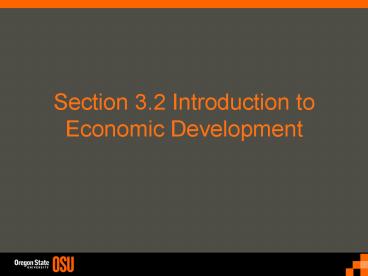Section 3.2 Introduction to Economic Development - PowerPoint PPT Presentation
1 / 22
Title:
Section 3.2 Introduction to Economic Development
Description:
Section 3.2 Introduction to Economic Development What is Economic Development? Income and Growth? Poverty and Inequality? Health and Happiness? Market Economy? – PowerPoint PPT presentation
Number of Views:375
Avg rating:3.0/5.0
Title: Section 3.2 Introduction to Economic Development
1
Section 3.2 Introduction toEconomic Development
2
Development Economics
Introduction
- What is Economic Development?
- Income and Growth?
- Poverty and Inequality?
- Health and Happiness?
- Market Economy?
- Political Rights and Freedoms?
3
Development Economics
Introduction
- Four Essential Aspects of Understanding Economic
Development in Class - Define development to the extent possible
- Describe different ways to measure development
- Describe theory to understand the mechanisms that
make developing countries different - Examine empirical evidence to see if theory is
right
4
Development Economics
Introduction Some Facts
- There are currently almost 6.7 billion people in
the world - In developing countries it is estimated that
(2003) - 826 million people do not have enough food
- 1 billion people have no access to safe drinking
water - 2.4 billion have no sanitation
- 10,000 children die EVERY DAY from diseases
caused by contaminated water - Source Weil (2003)
5
(No Transcript)
6
Development Economics
- Introduction (cont)
- Life expectancy at birth
- 77 for 1.1 billion who live in UN classified
high human development countries (HDC) - 67 for 4.05 billion in medium HDC
- 53 for 840 million in low HDC
7
(No Transcript)
8
Development Economics
- Introduction (cont)
- Other indicators
- High income 443 cars per 1,000
- Low income 9 per 1,000
9
Development Economics
- Introduction (cont)
- Other indicators
- Canada 667 telephone lines per 1,000
- Bangladesh 4 telephone lines per 1,000.
10
Development Economics
- Introduction (cont)
- Other indicators
- Continent of Africa 13 of worlds population
uses 2.9 of electricity - USA 5 of worlds population uses 25 of
electricity.
11
Development Economics
- Introduction (cont)
- Other indicators
- 20 of the world that lives in the richest
countries have 62 of the wealth. - 1.2 billion have incomes of less than 1 per day.
- 2.5-3 billion have less than 2 per day.
12
(No Transcript)
13
Development Economics
- Introduction (cont)
- Differences within countries over time are just
as dramatic - Life expectancy in Japan 1880 35
- Life expectancy in Japan today 81
- Between 1775 and 1975 the average height of a
male in Great Britain increased 3.6 inches from
better nutrition.
14
Development Economics
- Introduction (cont)
- Differences within countries over time are just
as dramatic - Since late 1800s in the United States the
fraction of income spent on recreation has
tripled. - The fraction spent on food has decreased by 2/3.
- In 1870 the average work week in US was 61 hours,
now 34.
15
(No Transcript)
16
Development Economics
- Introduction (cont)
- Even poor countries are rich by historical
standards - Egypt, Indonesia and Brazil have higher life
expectancy then British nobility in 1900.
17
Development Economics
- Introduction (cont)
- Things are getting better? - perhaps
- Fraction of people with incomes less than 1 fell
by 1/3 from 1980 to 1998. - But growth rate differences continue to be a
problem.
18
(No Transcript)
19
Development Economics
- Introduction (cont)
- Growth rate differentials lead to quickly
increasing inequality
20
(No Transcript)
21
(No Transcript)
22
Institutional Features
- Higher population growth rates
- Higher percentage of agricultural production and
rural residents - Rapid rural to urban migration
- Large involvement in international trade, much of
it in primary products and light manufactures































